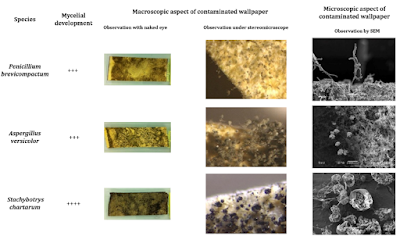By: Felicia Z. Paredez |
| Growth of different mycotoxin producing fungi on wallpaper. Figure taken from Aleksic et al. 2017. |
A humid indoor environment, like your bathroom, can harbor
fungi. Some fungi that produce mycotoxin can pose a health risk to any
individuals that are exposed. In a study by Aleksic and colleagues, they
measured the amount of toxins produced from fungi growing on wallpaper and the
aerosolization of these toxins. Mostly these toxic particles were aerosolized
from moldy wallpaper and the launching and concentration of the aerosolized
particles were dependent on the type of fungal species and the velocity of the
launch. It was found that under ideal conditions mycotoxin particles, small enough
to be inhaled deeply, could be aerosolized. This study shows that there is a
risk that building materials in our work and house environments can become
ideal spaces for the harborage of mycotoxin producing fungi. Consequently, it
also raises the question of “what is the long term risk of repeated exposure to
these particles and is there any way to avoid them?”.
Aleksic B, Draghi M, Ritouz S, Bailly S, Lacroix M, Oswald
IP, Bailly JD, Robine E. (2017). Aerosolization of mycotoxins after growth of
toxinogenic fungi on wallpaper. Appl
Environ Microbiol 83:e01001-17.


